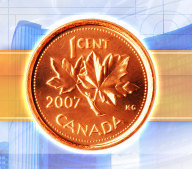The issue of public access to government data has a number of components: availability (is it available?), format (is it in a usable/open format?), cost (is it free?), and copyright (do I need permission to use it, may I do with it what I wish?).

The City of Toronto has recently launched a campaign to get more money for cities from the Federal government, asking for one cent from the GST. The campaign is called: onecentnow.ca, and uses the Canadian penny in ads and on their web site.
They’ve received a retroactive bill from the Royal Canadian Mint for $47,000+ for use of the image of the Canadian penny, and for use of the words “one cent” (!).
There are political/moral issues here about how government agencies use (or abuse) existing laws. Notably, the Royal Canadian Mint is a crown corporation that answers to the federal government, and the federal government is a target of the onecentnow.ca campaign, so this retroactive charge could be interpreted as politically motivated. Perhaps not.
And of course there are policy issues about how Crown Copyright ought to be used, or whether it should exist at all. In the USA, for instance, federal government documents, designs and publications are de facto in the public domain.
But other than these abstract concerns, there is a more crucial point: the Mint appears to be on the wrong side of the Canadian Copyright Act. As Howard Knopf points out in Excess Copyright, Canadian copyright law provides copyright protection until 50 years after the death of the creator. Crown Copyright extends 50 years after date of publication.
The Canadian penny was designed by G.E. Kruger Gray in 1937. He died in 1943, meaning that the design for the Canadian penny went into the public domain 50 years later, in 1993. Which means that no one, including the Royal Canadian Mint, can claim ownership of the image, much less charge for its use.
He notes further that it seems unlikely that any court would agree with the Mint that they own a copyright or trademark on the words “one cent.”
So it seems possible that the Royal Canadian Mint has developed an Intellectual Property policy that is claiming – and charging for – ownership where none exists.
-
Pingback from Fagstein » The penny isn’t free on October 9, 2007 at 3:19 pm
Comments are now closed.
1 comment